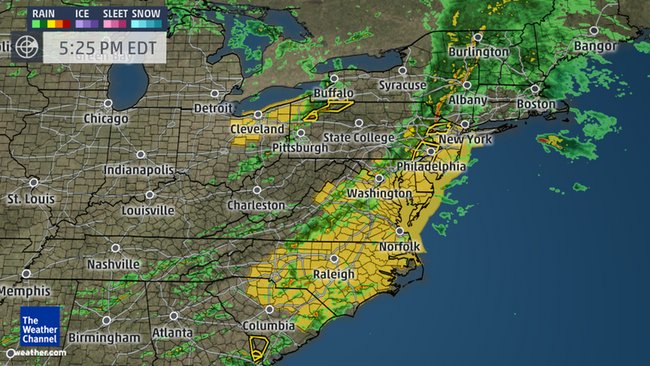
A severe thunderstorm accompanied by dangerous lightning, heavy rain, and strong winds may impact travel and cause localized flooding
June 5, 2016 — The New York City Emergency Management Department reminds New Yorkers of the potential for severe weather this evening. The National Weather Service has issued a Severe Thunderstorm Watch for the New York City area until 10:00 PM tonight.
A Severe Thunderstorm Watch means conditions are favorable for severe thunderstorms to occur close to the watch area. The heaviest period of rain and thunderstorms is expected Sunday between 5:00 PM and 10:00 PM, with dangerous lightning, heavy rain, damaging wind gusts and flash flooding possible.
“The heavy winds and potentially severe thunderstorms expected this evening may create dangerous travel conditions and localized flooding,” said NYC Emergency Management Commissioner Joseph Esposito. “New Yorkers should stay inside during periods of severe weather. If you are outside during a thunderstorm, avoid open areas and try to seek shelter indoors.”
A total of one inch of rain is expected with this event, but locally higher amounts are possible. Urban flooding may occur in low-lying and poor drainage areas. Flash flooding cannot be ruled out during the periods of heaviest rain.
The City’s Flash Flood Emergency Plan has been activated to ensure a quick, effective, and coordinated response to any flash flood events. The plan is activated when it is forecasted to rain one inch per hour for the duration of an hour or longer. Additionally, the City’s Downed Tree Task Force has been placed on stand-by. This multi-agency task force is responsible for coordinating the response to a large downed tree event.
Flash flooding can occur with little or no warning due to the large number of paved surfaces across the city. These surfaces do not allow rainwater to be absorbed into the ground and can result in storm drains often being overwhelmed, causing localized flooding. NYC Emergency Management works closely with NYPD, FDNY, Department of Environmental Protection, Department of Sanitation, Department of Transportation, Department of Parks and Recreation, and the Metropolitan Transportation Authority to mitigate the impact of flash floods. New Yorkers are encouraged to report clogged catch basins and areas of standing water to 3-1-1.
The National Weather Service has issued a Coastal Flood Advisory for Brooklyn, Southern Queens and Staten Island from 8:00 PM to 11:00 PM. During a Coastal Flood Advisory, minor flooding of the most vulnerable shore roads and/or properties is possible. Coastal residents should be alert for updates and take action to protect property.
New Yorkers are encouraged to sign up for Notify NYC, the City’s free emergency notification system. Through Notify NYC, New Yorkers can receive phone calls, text messages, and/or emails alerts about traffic and transit disruptions and other emergencies. To sign up for Notify NYC, call 311, visit www.nyc.gov/notifynyc, or follow @NotifyNYC on Twitter.
During a thunderstorm, NYC Emergency Management urges New Yorkers to remain indoors. To stay safe during a storm, New Yorkers should follow the safety tips below.
If you are indoors:
· Do not use showers, sinks, or any object, machine, or device connected to the building’s electrical wiring or plumbing systems. If lightning strikes the building, the current will likely flow through the electrical wiring or water pipes and you could receive a fatal shock.
· Wait 30 minutes after the last clap of thunder before venturing back outside.
If you are caught outside:
· Stay away from tall, isolated trees and other tall objects.
· Avoid open areas like fields or parking lots.
· Stay away from water and wet items.
· An automobile can protect you from a lightning strike because the current will flow through the car’s metal frame. If you are in a car, do not touch any exposed metal connected to the car.
· If someone is struck by lightning, call 9-1-1.
· Do not walk or drive through flooded streets, the actual depth of the water may not be apparent. Turn around, don’t drown!
· Flood water can be contaminated. Avoid contact with sewer water, as it poses a serious health risk.
· Have heightened awareness of cars, particularly when approaching or crossing intersections.
· Never touch or go near down power lines, even if you think they are safe.
· Report any downed power lines and avoid standing in flood water, as it can carry electrical current.

